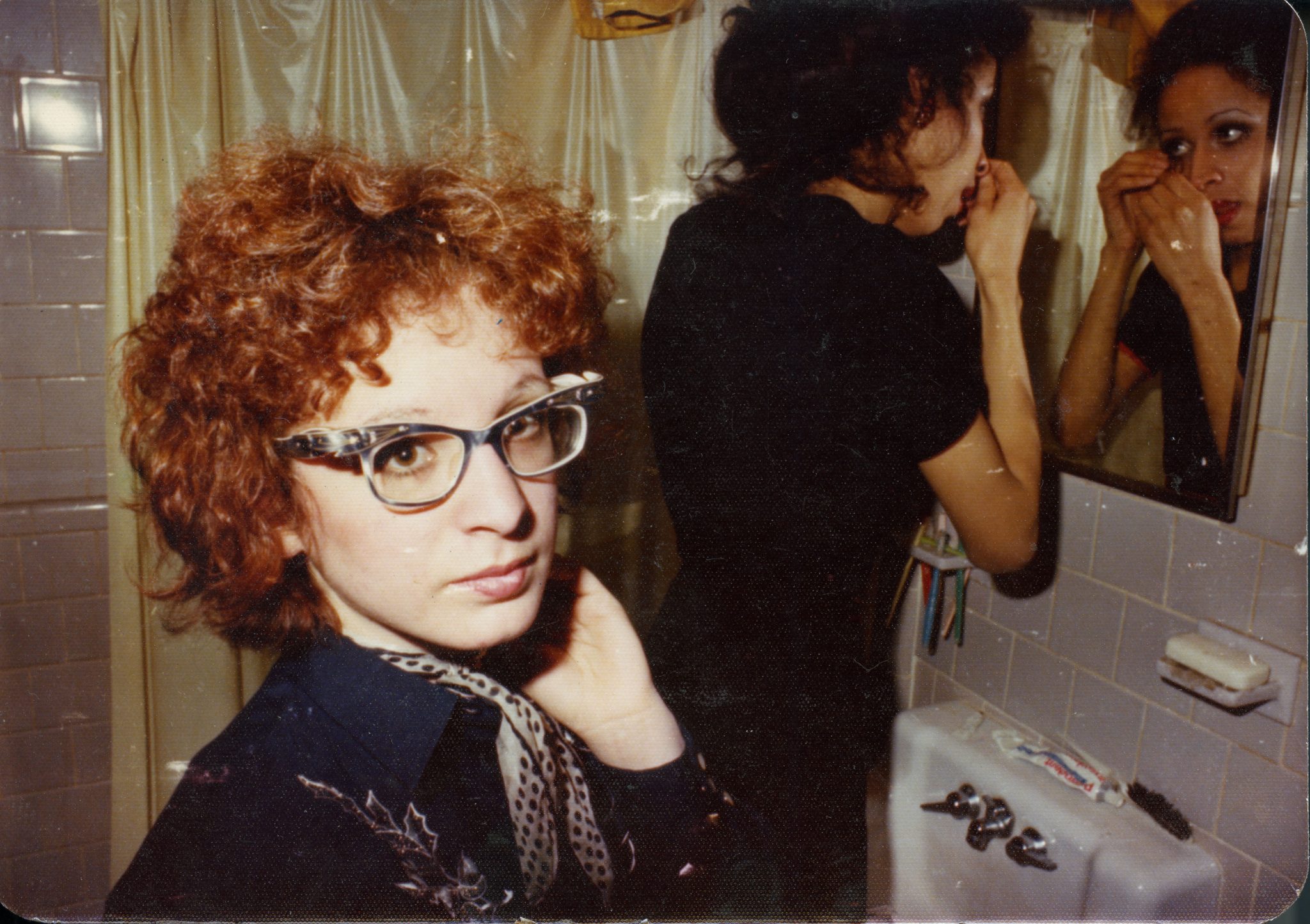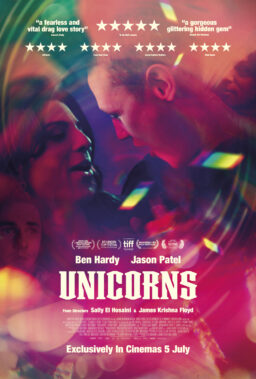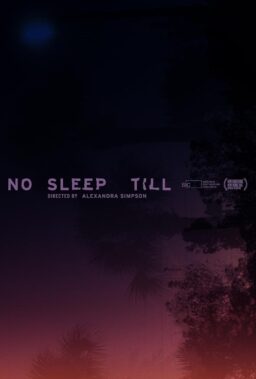We are pleased to offer an excerpt from the latest issue of the online magazine, Bright Wall/Dark Room. Their theme for this month is “Siblings,” and in addition to Frank Falisi’s excerpted essay below on Laura Poitras‘ “All the Beauty and the Bloodshed,” also includes new words on “Phantom Thread,” “Big Night,” “Fleabag,” “A Streetcar Named Desire,” “The Double Life of Veronique,” “The Color Wheel,” “The Lure,” and more.
You can read our previous excerpts from the magazine by clicking here. To subscribe to Bright Wall/Dark Room, or look at their most recent essays, click here.
David Wojnarowicz was born in Red Bank, New Jersey in 1954.
Red Bank is located in Monmouth County, a suburban subset just west of the New Jersey shoreline. The borough is bound on its north edge by the Navesink River, an estuary that made Red Bank a popular site for shipbuilding in the early 17th century and a hub of industrial production in the 18th. By 1844, textiles, furs, and leather were shipped up the coast to Manhattan. By 1860, a central railroad station meant that workers could commute into the city via locomotive and steamboat. They did, in droves. This exchange of bodies and goods made Red Bank a jewel in Monmouth County’s burgeoning band of suburbs and despite harsh economic prospects by 1987—”Dead Bank”, declared apocryphal chatter and the New York Times—the borough received an infusion of wealth when, in 1991, the New Jersey Development and Redevelopment Law designated the borough a special improvement district. In 2023, the borough looks—from the vantage point of a patio table at any of its luxury eateries—the picture of posterity.
By 1992, David Wojnarowicz was dead. He was 37 years old. Through the static of interview footage from a time between 1989 and 1991, his bassy voice transmits the feeling of living through the AIDS epidemic: “Mortality no longer feels like some abstraction that I could push away to the age of 80 or 90 or uh. You know, there’s no longer a luxury of, of pushing the idea of mortality away.”
It’s difficult to find a record of Wojnarowicz’s time in Red Bank. The artist was elusive about his early biography. By all accounts, it was a bad time. Wojnarowicz’s mariner father, Ed, dealt with alcoholism and was frequently physically abusive to his three children and younger wife, Dolores. The couple divorced when David was just two years old. He moved with his mother to New York City, where he would become one of the most prolific artistic voices to emerge from the East Village art scene of the 1970s. “It was a claustrophobic suburb. ‘Don’t let the neighbors know.’ My mother used to say that all the time. It wasn’t just an attitude. Actually the neighbors did know, we found out years later, ‘cause there was so much screaming in the house.”
This last quote isn’t Wojnarowicz. It’s his friend and collaborator, Nan Goldin, the subject of Laura Poitras’ most recent documentary project, All the Beauty and the Bloodshed. The film is a braided essay that weaves together Goldin’s history and memory, her activism and art. Its central strand, the tether that sustains the story’s inherent tension, is a negotiation of the way a specific set of historical and cultural conditions—a set that we call “the American suburbs”—lead to the institutionalization and eventual suicide of Goldin’s older sister, Barbara. “She made me aware at a very young age about the banality and deadening grip of suburbia,” Goldin recounts early in the film. Poitras’ movie and Goldin’s memorial are indictments of the conditions that lead to Barbara’s death and an insistence that we already possess the methods by which future deaths can be prevented.
Nan Goldin was born to middle-class Jewish parents in the Boston suburb of Swampscott, in 1953. We learn this fact via one of the film’s two chronologies, an oral history spoken by Goldin to Poitras. This memoired portion of the film moves from Goldin’s turbulent childhood through her time in Provincetown, then the Bowery and the Times Square art scene, all the while showing her artistic evolution as a photographer and exhibitor of her pictures. These sections of the film are accompanied by the photographs in question, excerpts from her constantly-evolving slideshows and installations. It is unclear who selected which photographs to display, what their arrangement or duration onscreen would be. The inclusion of footage wherein a meticulous Goldin (“I could do this all night, watch out”) works with gallery staff to find the perfect wall spaces for her photos suggests that the artist is more than just a subject of Poitras’ camera.
Simply by virtue of Goldin’s photography and testimony occupying such a large space in the film, All the Beauty and the Bloodshed is best understood as a collaborative portraiture, one written in concert by two artists equally invested in the power images have to influence the governance of both emotions and systems. The film frames image construction as a record-making process—proof of the materiality of a given situation, political or otherwise—and also prioritizes the wibbly and fluid architecture of memory. The documentary isn’t asserting itself as the authority on the subject, it lets the subject remember herself.
Intercut with this oral history are segments of footage—detailing a stretch of time between 2017 and 2020—that catalogs Goldin’s leadership of the activist group P.A.I.N. (Prescription Addiction Intervention Now), which she founded in the wake of her recovery from opioid addiction, in the wake of finding out that responsible for the invention and proliferation of OxyContin was a single family, the Sackler family. The Sacklers—first the three brothers Arthur, Mortimer, and Raymond and then their descendants—amassed a vast wealth through medical advertising that incentivized prescription-writing, first for Valium, invented by the first generation Sacklers and then OxyContin, the product of the second. The Sacklers—and their proxy company, Purdue Pharma—insisted on OxyContin’s safety while overlooking numerous warning signs that the drug was highly addictive in the process. They made more money than is comprehensible while creating the conditions that would catalyze the opioid. To launder their money (if not their consciousnesses), they became a prolific philanthropic machine, especially in the forums of arts and medical institutions. “Leave the world a better place than when you entered it,” Arthur Sackler told his children before he died in 1987.
After being prescribed OxyContin for a wrist injury Goldin became, like millions of others, addicted to chasing the potent opioid’s highs, to the point of having to find other, more volatile methods of relief. When she overdosed on a fentanyl-contaminated supply, she was able to receive Medically-Assisted Treatment. “I wouldn’t have gotten off Oxy without buprenorphine. On a small dose of buprenorphine, cravings for opioids are reduced. At larger doses, you can’t even feel the effects of opioids if you try. I was one of the lucky ones,” she says in front of the New York State Assembly, gathered to discuss funding (or the lack thereof) for substance use disorder services. “Doctors need to pay to train and receive a waiver to prescribe buprenorphine, when no such certificate is required to prescribe OxyContin.”
Encapsulated in this moment is a miniature illustration of the film’s thesis: being deserted by a defunded welfare state ravaged by corporate greed, the best thing any of us can do is reduce harm, for ourselves and each other. The best thing the constructed image can do is to witness us, which is to say, testify to our living as opposed to our dying. In All the Beauty and the Bloodshed, the act of witnessing becomes an act of solidarity, in joy and of pain. This is what a cinema of more life looks like.
Patrick Radden Keefe’s Empire of Pain (2021) details the twin rise of the Sacklers and their most enduring legacy, OxyContin. In the book’s last section, the journalist provides a sketch of Nan Goldin: he references her 2018 Art Forum piece`and observes her immediate instinct to combat the Sacklers via direct action in P.A.I.N. He notes the supposed belief by some of her collaborators that Goldin’s committed planning and enacting was itself—in addition to emerging from a sense of social responsibility—a coping strategy, an element of her recovery. This observation, when it appears in the book, feels a bit pat, a prescriptive take when the descriptive power of sketch and portraiture are perhaps stronger tools in Keefe’s toolkit. To the journalist’s credit, his appearance in All the Beauty and the Bloodshed as a kind of ancillary source is marked by a modicum of sheepishness. Describing Goldin’s spirit, he confesses, “and I probably was…I blush to think, but I probably was gently patronizing and said, ‘well, good for you, glad to hear it.’”
I am not sure if Goldin needed her activism in the later 2010s in the same way that she needed her art earlier in life. That framing risks a kind of binary unfit to bring to Goldin’s photographs, which by virtue of their subject matter—their recentering of who has access to attention and affection—are engaged in a political project. More revealing in Keefe’s reading is a demonstration of how easy it is to project onto her. This is especially true in the way Poitras’ camera scrutinizes her, in the way that same camera watches other people watching her. Her moptop of red curls are elegant, a little wild. She is perhaps the first and only human being to make vaping look cool. In P.A.I.N. sessions, she is direct but speculative, committed to keeping the group focused on specific goals and alert to when “not realistic” is a limiting designation rather than a pragmatic one. More vitally, she is a natural collaborator, working alongside Megan Kapler, Mike Quinn, Harry Cullen. When Goldin speaks of old friends and comrades, she has a wry generosity, a gracious refrain she keeps sounding: “The relationships that have mattered most to me, probably my whole life, are my friends. I only escaped because of my friends.”
All the Beauty and the Bloodshed is not The Nan Goldin Story, no matter how compelling she is. It is the story of how collaboration and love and lust and desire—for each other, as in, I want more of you—can become vital to a tangible political line. The film is portraiture that teaches—it is for somebody else. And so as Goldin reads a prepared statement in front of the New York State Assembly, her recitation more formal than usual, Poitras responds with a deft and gracious move. Goldin talks about the difficulty of getting Medically-Assisted Treatment and how that difficulty is the result of the pernicious American mythologizing of people struggling with addiction as derelict and immoral. “Again, this is a policy that increases the stigma in the medical community about treating people addicted to drugs.” The camera has largely remained on Goldin throughout her testimony. Now it cuts away to Assemblywoman Rosenthal, an advocate for progressive drug policies centered on harm reduction. “People need to be kept alive,” Goldin says, now off-camera. The camera moves away from the charismatic subject and widens not only to the public but to a public representative, representing another aspect of how people can be kept alive. This is how we can reduce harm, this motion speaks, in tandem with Goldin’s politics of protest, in tandem with Poitras’ witnessing mechanisms.
Harm reduction keeps us alive. Direct action moves the world from something we endure into something we can live a full and safe life in. The segments of All the Beauty and the Bloodshed that detail P.A.I.N.’s direct actions are kinetic setpieces, apprehended by Poitras’ keen eye for the shapes inside frames: orange pill bottles bob in the Louvre’s fountain pool, mock prescription slips thresh and wiggle down the conical hall of the Guggenheim, still and breathing bodies litter the Met’s Sackler wing. The die-in is an inherently theatrical act, a simulation of one form of being by another, not an empathic gesture but one of deepe solidarity, reaching past differences in experience into the reaches of death itself. We’ll see a few different die-ins in All the Beauty and the Bloodshed, a reminder to the viewer as much as the museums and institutions that, with every day, there is more death as a result of an epidemic motivated by one family’s lust for wealth.
After the initial volley of chants in this first die-in at the Met, the protestors lie in silence. At approximately the 3:04 mark of the film, the camera cuts to a Black man, lying down, still, eyes open. His voice leads the call of the mock dead: “Sacklers lie! People die!” Standing over him are two white children, dressed cozily, rapt. It’s a perfect image to alight on, a reminder that photography is the lingua franca between Poitras’ investigative frame and Goldin’s instigative images. A photograph is like a reflecting pool: it gives a facsimile of a subject, of its history and shapes, but not without the distortion of a different material.
I’m projecting now. In the still image from 3:04, I see two young children—a brother and a sister—brought into Manhattan from their suburban New Jersey home. There was light tunnel traffic en route but the car was comfortably climate-controlled, stocked with snacks. And now they are seeing something they’ve never seen before. They are unsure if it, too, is ‘art’. They look on, bemused but not afraid. They don’t see this kind of thing in the suburbs, a word they don’t yet realize means ‘nowhere.’
I am projecting a deep anxiety about the American suburbs onto Nan Goldin and All the Beauty and the Bloodshed because I was raised in them. I still move through them. Their fungal architecture—colonizing, silent, un-lifed—informs my mental mapping instinct as much as the natural world. I see in mall Food Courts and cul-de-sacs, smell in over-manicured cut grass and the sticky-sweet cleaning products of too many houses for too few people. The dream of the suburbs is “quiet,” a code word for isolation: Ring cameras monitor those outside of houses and corporate conglomerates sell goods and leisure to those inside them. Freehold, my hometown—twenty minutes from Wojnarowicz’s Red Bank—recently received a glowing write-up in the New York Times’ ‘Living In’ section. The piece advertised the suburban town as slow-paced but active, with good schools and plenty of 55+ housing. The piece seemed specifically geared towards young couples and nuclear-family-aspirants looking to flee the crowded, escalating rents of New York City. “By the time you get to Freehold, everything seems to open up a lot more,” one new resident boasts, sounding like an extra in The Truman Show.
I am grateful for the spaces I was able to find in Freehold, pockets of the weird and the niche among the picket fences. I was lucky to have a family that was able and willing to support me, both materially and in finding my own weirdnesses. I only managed to escape because of my friends. It’s hard to stomach the framing of Freehold—or any suburban enclave—as idyllic, even if speaking about them in the real-estate section is using the only language these spaces can communicate in. I consider a former classmate M, who was killed in a drunk-driving accident when we were 22. I consider another former classmate P, who struggled with mental illness and substance abuse. He committed suicide when we were 28. I consider the way the good school I attended used to speak about these boys as aberrances, trouble-makers, nuisances. Neither of their families’ homes are pictured in the Times’ article.
Also elided is the fact that Monmouth County—which contains Freehold and Red Bank and is one of the most affluent counties in New Jersey—consistently has the third or fourth-most drug-related deaths. The majority of these deaths come via heroin and fentanyl. I imagine what it would look like if instead of an occupying force of tax-payer-funded law enforcement there were social services and mental health professionals littering every sidestreet. I imagine what it would look like if Monmouth County Commissioners were pushing through needle-exchange programs and harm reduction centers instead of Parents Bills of Rights inspired by right-wing fearmongers. I imagine what it would sound like if we didn’t tell ourselves there was nothing we could have done for those boys, for the millions of other people who die because the country has assigned them a designation of less inherent value.
These situations are not Barbara or Nan Goldin’s. I am projecting. But the narrative heart of All the Beauty and the Bloodshed contains the failure of the American suburbs, a failure of human structures that willingly prioritize profit and affluence over people who need support and attention. Nan Goldin’s parents failed to care for another person, their daughter Barbara. “My father and mother were not equipped to be parents,” Goldin says near the film’s end. “They had children because it was expected more than it was about nurturing other human beings.” They sent Barbara first to an orphanage, then an institution, where psychiatrists wrote that she was experiencing normal adolescent behavior, that instead it was her mother—a victim of sexual abuse in her own childhood—who should be receiving treatment of some kind. Instead, Barbara Goldin laid down on a train track. This film is for her as much as it is for anyone else.
There is no immediate or obvious respite—the gnarl of ballooning rents, fungal gentrification, and rising eviction rates in cities like New York mean it’s harder all over to have a home, here or there or anywhere. There is, by the grace of each other, making art and making love, direct action and harm reduction. Part of watching All the Beauty and the Bloodshed is to see a New York that doesn’t quite exist anymore, or that doesn’t exist as easily, but that might be possible again if we don’t forget it. And so when David Wojnarowicz appears walking around a Tribeca gallery two-thirds of the way into the film, a body can’t help but break and leak. He can’t appear in the present-day footage of P.A.I.N.’s activism because his country murdered him before his future could happen.
This grief will not be treacly. David Wojnarowicz was not a victim of AIDS. Any history that frames him that way misses the point of his art, his activism, of ACT UP, and Nan Goldin and All the Beauty and the Bloodshed: we have the power to resist the designation of victimhood and the ability to author our existence so long as we do it together. In December of 1989, hundreds of Arts Institutions throughout New York and the US closed for the day, “A Day Without Art” in protest of the ongoing epidemic and the refusal of the US to help people not die. In protest, something more potent than memorial emerges: solidarity. “My sister was a victim of all that,” Goldin says, of her parents’ abuse and the suburbs’ alienting indifference. “But she knew how to fight back. Her rebellion was the starting point for my own. She showed me the way.”
Wojnarowicz speaks for Peter Hujar and Keith Davis, Bebe Smith and Cookie Mueller and Vittorio. He talks about memorials, about remembering, about what we do. “I imagine what it would be like if each time a lover or friend or stranger died of AIDS, their friends, lovers, or neighbors would take their dead body and drive with it in a car 100 miles per hour to Washington, D.C., and blast through the gates of the White House and come to a screeching halt before the entrance, and then dump their lifeless forms on the front steps.” I imagine how Wojnarowicz’s comrades and lovers made sure his action continued after death—Wojnarowicz’s ashes were spread on the White House lawn during a 1992 ACT UP action, perhaps the most important movie a camera ever caught.
Every time Poitras’ film makes me cry, I feel the limitations of documentary convention. Every time I cry, I feel the limitations of unactivated sadness. The film’s true formal innovation, I think, is how it leverages the emotions finely-calibrated documentaries exorcize and marshalls them towards actionable outcomes. It’s not that the film isn’t working to manipulate image and sound and narrative to play on pre-existing threads of anger and melancholy, it’s that this process is pointed towards concrete examples of what to do with those emotions rather than left to die alone in the content stream. The final, sticking bravery of Nan Goldin is that she steers this memorializing artifact of documentary into an object of direct action. She brings Barbara with her, renders her portrait in clear-eyed strokes, and then dumps the body at our doorstep. What do we do with it?
I imagine what it would be like to actually exist for each other, lying together decadent, lying together resisting. I imagine what a live-in would look like, what songs we would play—what a relief the beat and giggle would sound like. And so long as I am a body, it is for you. And after I stop being a body, it is still for you. We exist for each other. Just like the movies say, I see you.











